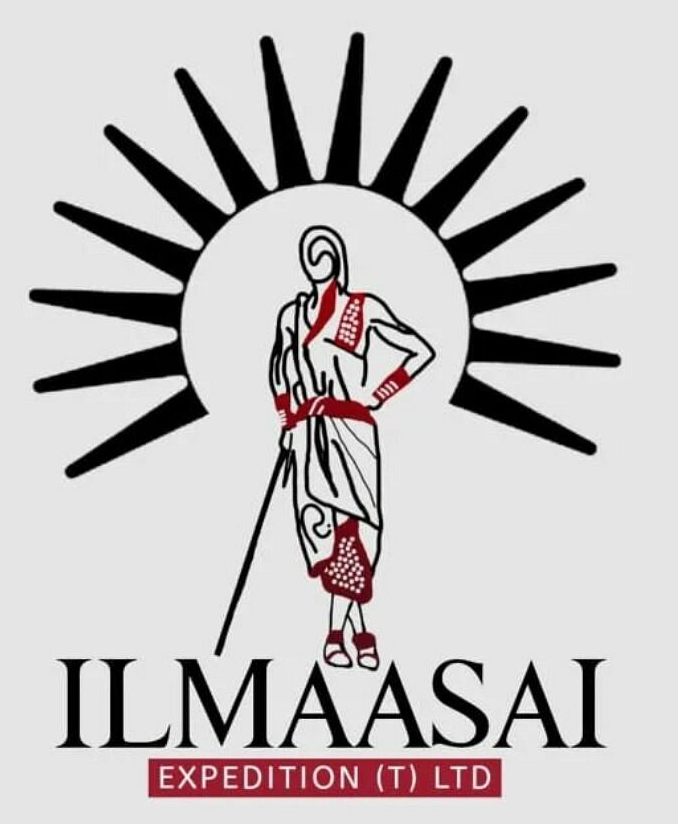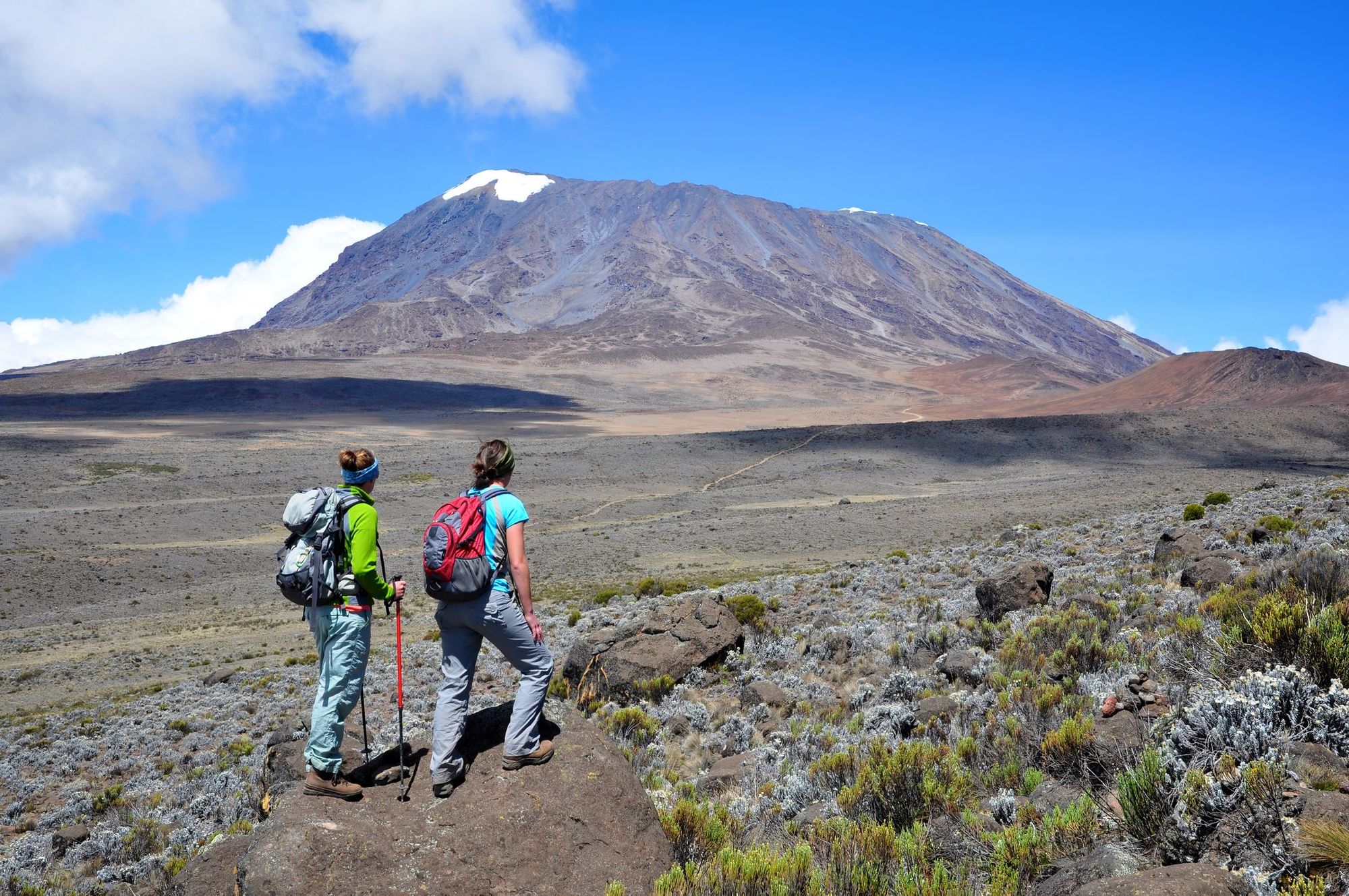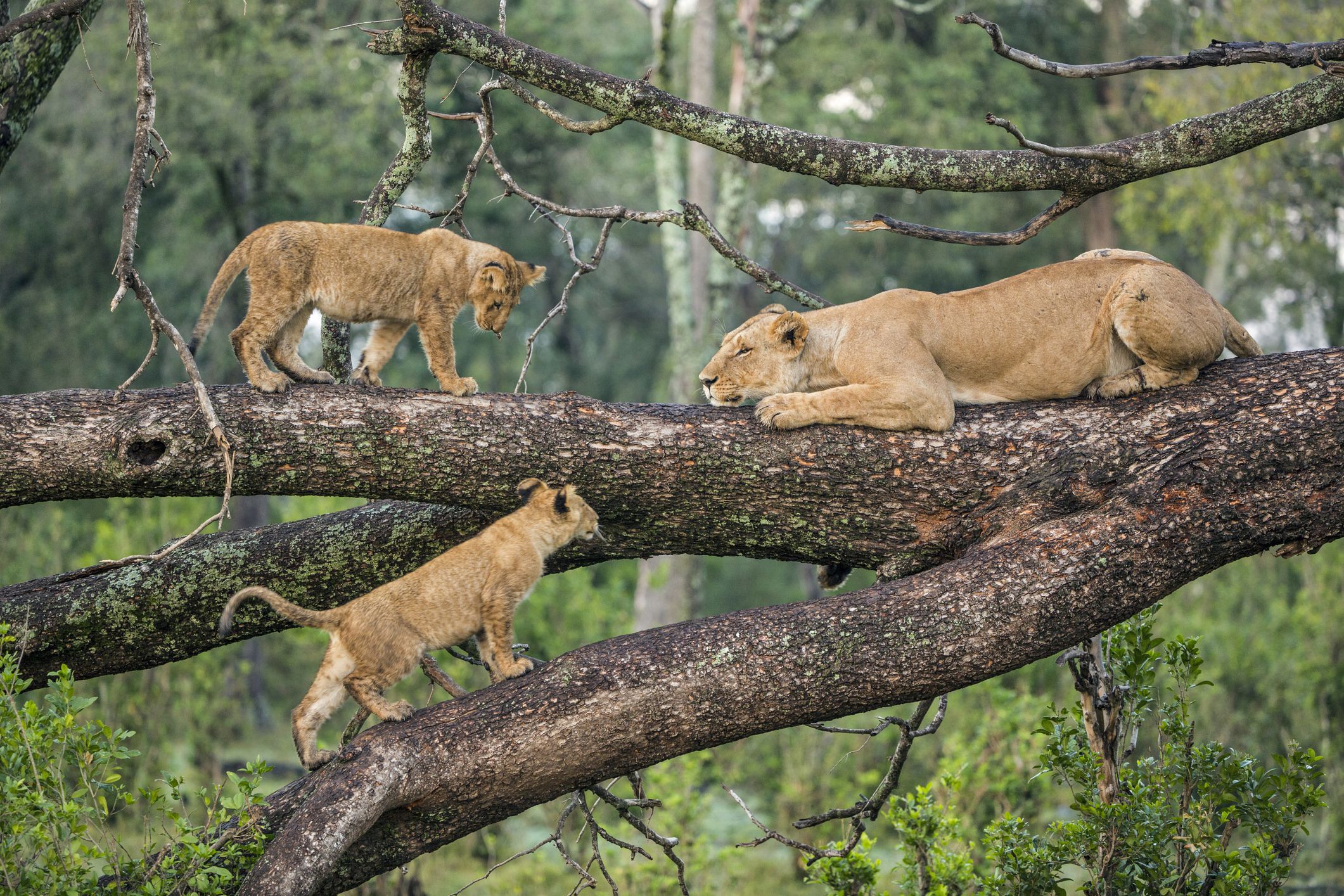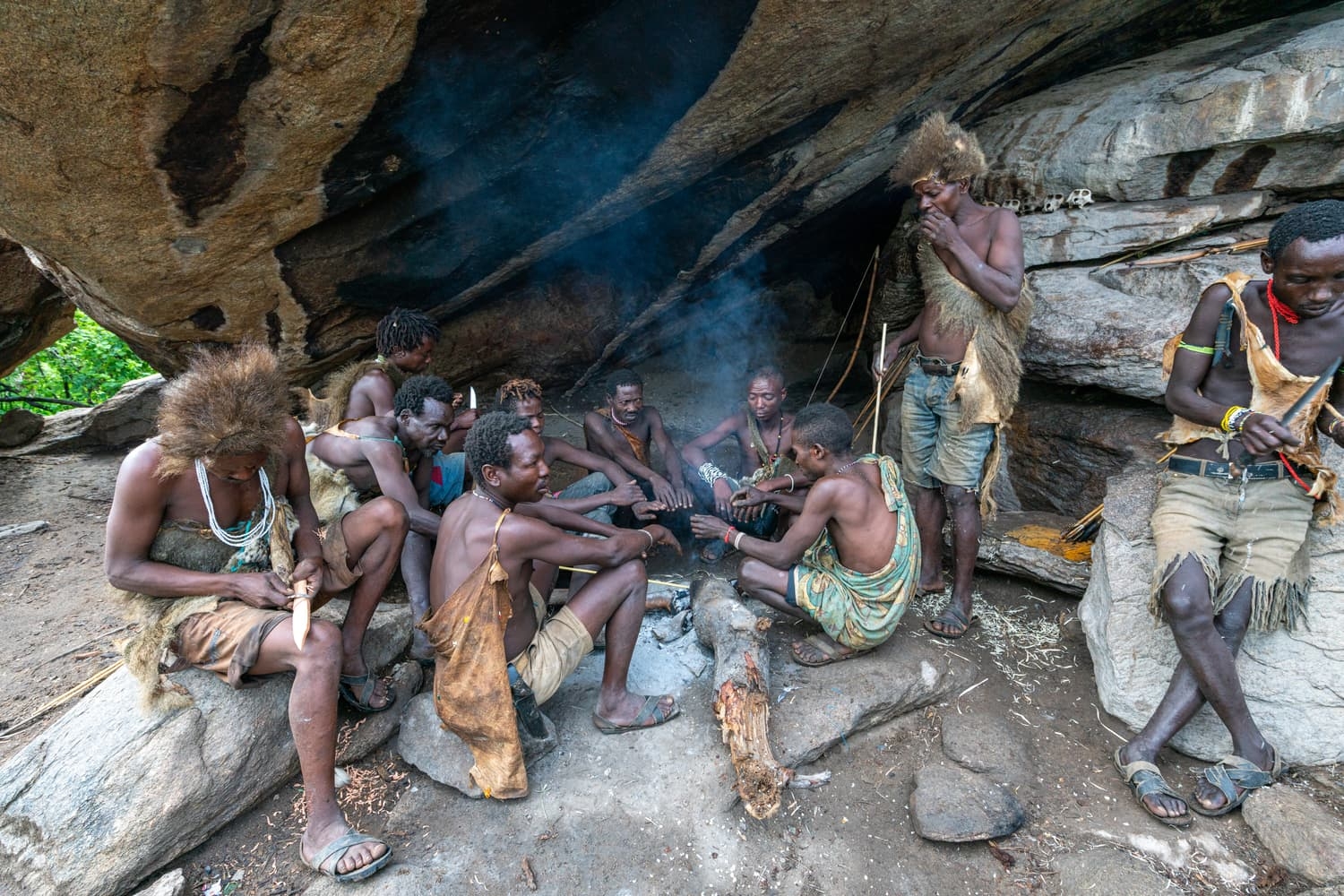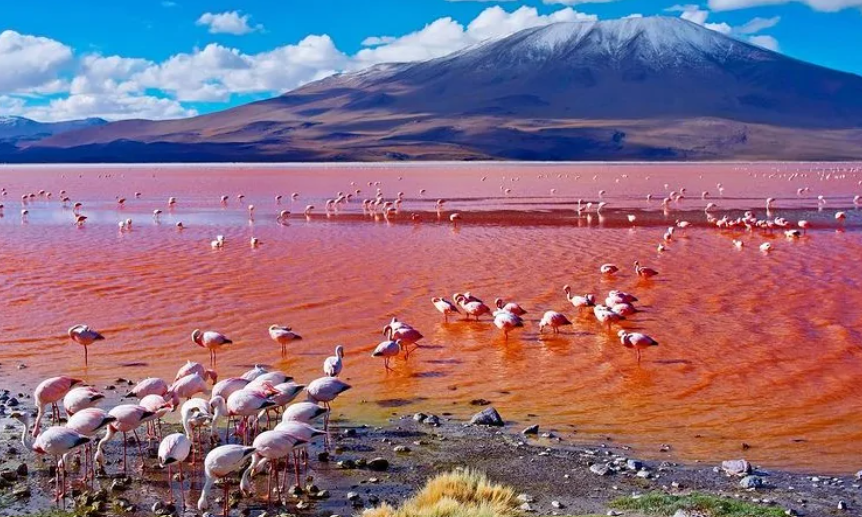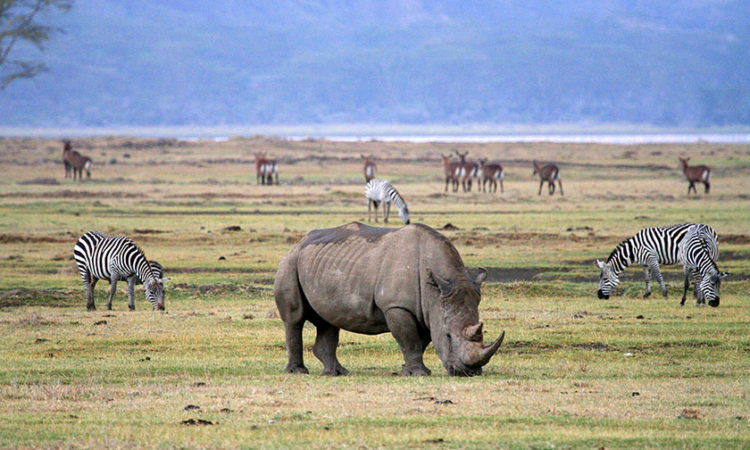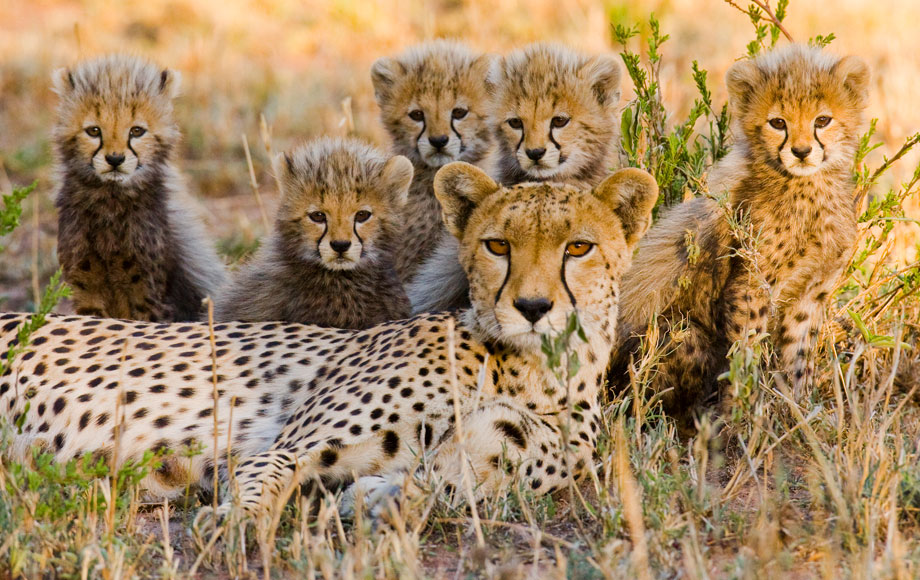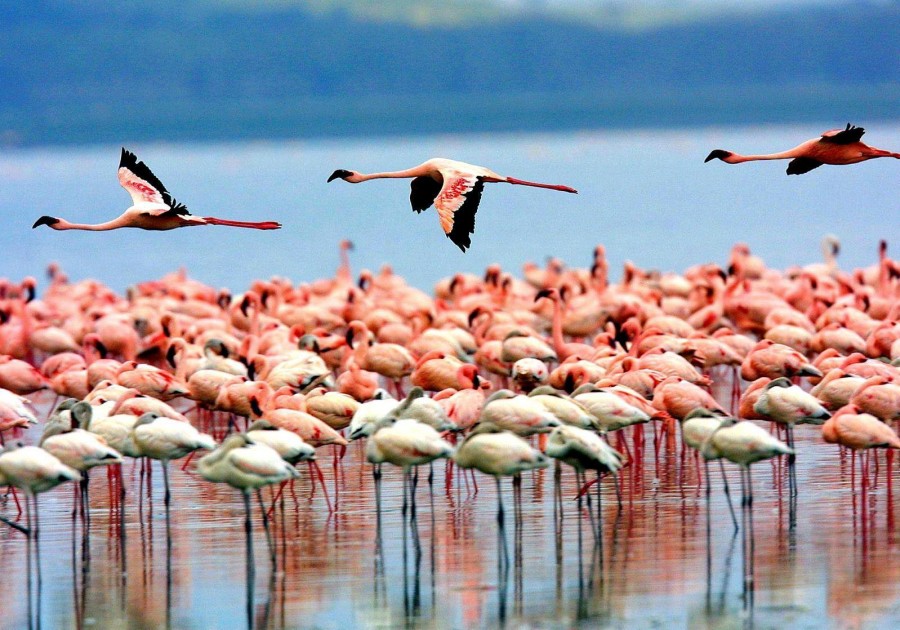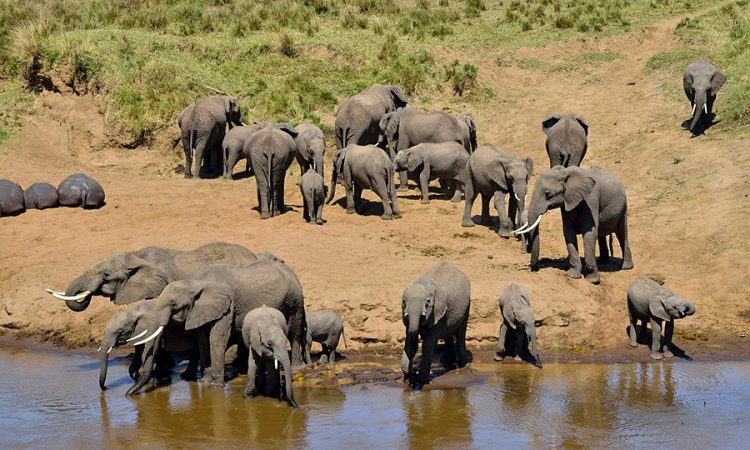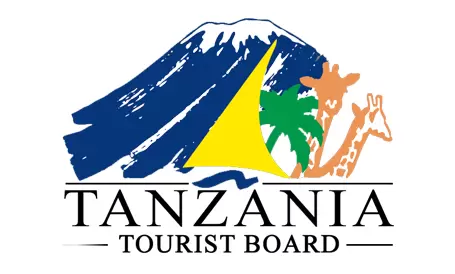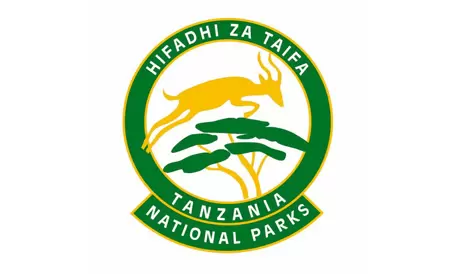Mount Kilimanjaro is the highest free-standing mountain in the world (5,895 metres, 19, 341 ft). Climbing Kilimanjaro is an unforgettable adventure. Of which people say: “You should do that ones in your life!” Mount Kilimanjaro Mount Kilimanjaro is Africa’s highest mountain and the tallest free-standing mountain in the world. Each year it attracts thousands of climbers and adventurers from all over the world. Climbing Mount Kilimanjaro is like walking from the tropical to the arctic in just one week. It is a real challenge due to the altitude and the rate of ascent, but also extremely rewarding. In 1987 UNESCO listed Mount Kilimanjaro as World Heritage Site because of its natural beauty. The variety of vegetation and landscapes is amazing due to the mountains location and immense height. From tropical rainforest with monkeys and birds to the ‘Roof of Africa’ where you see glaciers and an impressive snow-capped summit. On a classic climb you pass through one vegetation zone every day and a half. The thrill of reaching the top of the Mount Kilimanjaro after days of walking is amazing. At the summit you are rewarded with breathtaking views of the African savannah and Rift Valley. Climbing Mount Kilimanjaro is absolutely an experience of a life time! Everyone can climb Africa’s highest mountain! Do you have the dream of climbing Mount Kilimanjaro but wonder if you can make it? Climbing Mount Kilimanjaro is certainly a challenge, but you don’t need to be an experienced climber to reach its summit. If you are healthy and fit it is absolutely within reach. We have an experienced and professional team that can bring you to the top safely. That is why 95% of our guests reach the top of Africa’s highest mountain. There are many things you can do to increase your chances to reach the summit and to make sure you enjoy the trek. One of the things is buying good gear and practice hikes in your home country a few months before your departure. Since altitude sickness is the main reason people fail to reach the top, it’s important to take your time. Give your body time to acclimatize. Check out below which climbing route fits you best. Support the Mount Kilimanjaro porters Porters make it possible for you to climb Kilimanjaro. They carry all your food, gear and supplies and are an essential part of your mountain experience. Without their commitment and hard work, you are not able to climb and enjoy the magnificence of Kilimanjaro. Unfortunately local porters are often exploited and have poor working conditions. That is why we support our porters, this helps improving the working conditions of the porters on Kilimanjaro. If you book a climbing Kilimanjaro trip with us, you automatically contribute to a fair treatment of Kilimanjaro porters. Climbing Kilimanjaro routes Recommended? Rec. number of days Fitness Scenery Traffic Marangu recommended 5 -6 days Average good high Machame strongly remcommended 6-7 days Avarage excellent high Lemosho strongly recommended 7-8 days Avarage excellent Medium Northern Circuit recommended 9 days Avarage excellent low Rongai Only for professional climbers 6-7 days very fit good low Shira not recommended 6-7 days very fit excellent medium Umbwe not recommended 5-6 days extremely fit good low Best route for climbing Kilimanjaro? Once you have decided to climb Kilimanjaro, the main question now is which route you should choose. There are seven different routes to the summit. They all vary in length, difficulty, scenery, traffic, accommodation and other aspects. Based on our experience we advise you to choose one of the first 3 routes. Machame routeThis is one the most popular climbs due to the diversity and beauty of the route. You walk from green rainforest to the beautiful Shira Plateau and the rock lava slopes. The trail circles around the mountain with spectacular views. Another advantage is the gradual ascend, so people have more time to acclimatize, which increases the success rate. The Machame route, also known as the “Whiskey route” has an average to high success rate, especially if you choose the 7 days itinerary. This route is less expensive than most others but has the disadvantage to be quite busy. Lemosho routeThis route is known for its varied and breathtaking scenery. The Lemosho route is also less crowded with climbers than some of Kilimanjaro’s longer established routes. Although Memosho is a more expensive route, it gives climber plenty of time to acclimatize properly. This route is remote and beautiful. High success rate. Marangu routeThe Maranga route is the second most popular route and cheapest one to reach the top of the Kilimanjaro. It is the only route that uses the same trail to ascend and descend and offers hut accommodation (camping is not allowed). This route, nicknamed the “Coca-Cola” route, has a reputation of being one of the easiest paths on the mountain. It certainly is the shortest Kilimanjaro route, yet it gives climbers less time to acclimatize and clarifies the lower success rate. Marangu is unfortunately less scenic than other routes and can be crowded during the peak season. Northern Circuit routeThe Northern Circuit is the longest Kilimanjaro route and also one of the most beautiful and enjoyable ones. The route circles around the mountain and offers great views from all sides of the Kilimanjaro. The summit success rate is very high, as the route is long and gives lots of time to acclimatize. This is a great route for those who want to experience all the beauty Kilimanjaro has to offer and have time and money. Shira routeThis route is very scenic, but also expensive and difficult. We only advise experienced climbers to choose this route due to the high starting point of the route, which gives the body less time to acclimatize. Rongai routeThis route suits the more experienced climbers. Since the ascent and descent are on opposite sides, climbers can see both sides of Kilimanjaro. At the same time this additional transport, to reach the other side, makes the climb more expensive. Rongai
Arusha National Park
Arusha National Park is known for the black-and-white colobus monkeys, Mount Meru, swamps, lakes, waterfalls and craters! A beautiful park with a wide diversity of landscapes and wildlife. Arusha National Park Arusha National Park is a small charming park, located in the northeast of Tanzania. It is near the city of Arusha and provides great views of the Mount Kilimanjaro. The park is a scenic and diverse park which offers a wide range of animal and plant species. And it also has a rich diversity of landscapes. From lakes, waterfalls and swamps to volcanos, mountains and tropical rainforest – the ideal reserve for all kind of animals. The swamps, rainforest and lakes attract many beautiful birds including silvery-cheeked hornbill and thousands of pink-hued flamingos. This park is also the only place in northern Tanzania where you can easily spot the black-and-white colobus monkey. Mount Meru Mount Meru is located within Arusha National Park. This dormant volcano is Tanzania’s second highest mountain at a height of 4,566 meters (14,990 feet). It is a beautiful, but challenging mountain to climb. The panorama views from the summit over the steppes of the park, Mount Kilimanjaro and the Momella Lakes are spectacular. A day hike on Mount Meru gives you another perspective and offers a nice change. We also organise climbs to the peak… Canoeing on the lake or walking safari One of the popular safari activities in Arusha national park is a canoe or walking safari with an armed ranger. The Momella lakes in the northeast for example offer a large variety of animals. They are in an open landscape and are home to hippos and all kinds of birds. Countless bucks and buffalo can be seen near the lakes. A great change to enjoy wildlife up close, from a different perspective than sitting in a safari vehicle. Absolutely a memorable safari experience! Most common animals in Arusha National Park Buffalo, Giraffe, Zebra, More than 400 bird species including flamingos,. Monkeys: black-and-white colobus monkey, vervet monkey, blue Monkey, baboons, Hippo, Waterbuck, Bushbuck, Warthog, Optional Safari Activities: Balloon Safari (USD 590 per person) Maasai Village Visit (USD 50 per vehicle) Night Game Drive Tarangire or Lake Manyara (USD 120 per person) Ngorongoro Crater Rim Walk (USD 30 per person) Visit to the Olduvai Gorge and museum (USD 40 per person)
Lake Manyara National Park
Rift Valley, hippo pool, birdlife, troops of baboons, flamingos, elephants, giant soda lake and the beautiful scenery make Lake Manyara incredible diverse. Lake Manyara National Park Lake Manyara National Park is a popular destination because of its breathtaking scenery, the enormous soda lake full of flamingos and outstanding bird life. You can see huge troops of baboons roaming around in the forest, but also herds of elephants and if you are lucky even some tree-climbing lions. Around the soda lake one can spot a variety of wildlife, like buffaloes, warthogs, giraffes, wildebeest and zebras. You can also enjoy excellent hippo sightings at the shallow Hippo Pool. Sometimes you can find big numbers of them taking a cooling mud-bath and hiding from the hot sun. Rift Valley Escarpment Lake Manyara is also a perfect place to see the spectacular 400 meter high Rift Valley Escarpment. The Great Rift Valley is a long rift in the earth which runs down the eastern side of Africa. It was formed about 20 to 25 million years ago when the earth’s crust teared apart. This enormous feature is even visible from outer space and looks like two lines running down Africa. It provides unique and diverse habitats. Enjoy acacia woodland, jungle forest, mountain cliffs, hot springs, grassy areas, acacia woodland and the huge soda lake. Check the Safaris to see how Lake Manyara can be incorporated into an itinerary. Most common animals in Arusha National Park Zebras, Hippos, Giraffes, Lions, Elephants, Impalas, Wildebeest, Buffaloes, Flamingos, Baboons, Blue monkey, Optional Safari Activities: Balloon Safari (USD 590 per person) Maasai Village Visit (USD 50 per vehicle) Night Game Drive Tarangire or Lake Manyara (USD 120 per person) Ngorongoro Crater Rim Walk (USD 30 per person) Visit to the Olduvai Gorge and museum (USD 40 per person)
Lake Eyasi
Guests are invited to overnight in these tribal lands as well as witness how these people continue to hunt and forage for their food in the face of Tanzania’s continued development. Observing an early morning hunting display, gathering honey, and traditional dance performances are all part of the experience.It is a cultural experience not to be missed, and it all happens against the backdrop of beautiful Lake Eyasi. Lake Eyasi is situated at the southwestern end of the Ngorongoro Conservation Area between Great Rift Valley Eyasi escarpment and Kidero mountains, just 133 km (95 miles) west of Lake Manyara. Lake Eyasi cover an area of about 1,050 square km (400 square miles). The lake is as all the other lakes in the Rift Valley a soda lake. Lake Eyasi, which has one principle spring, the Sibiti River, is enclosed with walls consisting of purple lava. The main attraction of Lake Eyasi are the Hadzabe bushmen, the indigenous inhabitants and the last community of hunters and gatherers in Africa. Lake Eyasi is their homeland for over 10,000 years. They are still holding to their traditional way of life, hunting and gathering different kinds of fruits and honey. The Hadzabe live in caves and they don’t wear any kind of clothes but rather skin to cover the private parts. Their community is endangered, because most of their land has been taken away from them for commercial production and they are forced to join the civilization. Lake Eyasi is also inhabited by another bushmen community, the Tindiga. This community is also a hunters and gatherers community, but they are tired of this kind of live and want to join the civilized world. They have been living for centuries from the forest and its products, hunting animals such as monkeys. The Tindiga people don’t have permanent houses and avoid buildings with iron sheets, because they believe they cause blindness.
Lake Natron
Lake Natron is a salt or soda lake not far from Lake Manyara in northern Tanzania. It is located in the Gregory Rift, the eastern branch of the East African Rift. The lake lays at the foot of the Ol Doinyo Lengai, an active volcano. Lake Natron is quite shallow, less than three meters deep, and varies in width depending on its water level. The lake is 57 kilometers long and 22 kilometers wide. The area receives irregular seasonal rainfall, mainly between December and May. The temperatures at the lake are often over 40 ° C. As the fresh water evaporates in the lake, water with high concentrations of salt minerals such as sodium and trona remains. The alkalinity of the lake can reach a pH level of more than 12. Special bacteria and blue algae thrive in this environment and form an ideal breeding ground for the life of birds. Such halophilic organisms include some cyano bacteria that, like plants, produce their own food through photosynthesis. The red pigment in those cyano bacteria produces the deep red colors of the lake’s waters and the orange colors in the shallow areas. Salt-loving microorganisms living there are coloring the alkali salt crust on the surface of the lake is red or pink. Lake Natron, the perfect breeding place for Flamingos Flamingos find a safe breeding ground at Lake Natron, since most other animals find its caustic environment and high temperature of the lake (up to 60°C) as well as its high salinity inhospitable. It therefore provides a good barrier against predators trying to reach nests on seasonal evaporation islands. Every year, more than two million flamingos come here to lay their eggs and chicks hatch between September and April. Cyanobacteria are increasing with the salinity of the water, and the lake can carry more nests. Larger flamingos also breed in the Wadden Sea. Other animals in Lake Natron Some fish species (such as tilapia) can survive in the slightly less salty water near the shore. Lake Natron is also home to some endemic algae, invertebrates and other birds. Tens of thousands of other birds can be spotted near the lake, making Lake Natron a prime destination for bird lovers in Africa.
Ngorongoro Crater
Ngorongoro Crater is the main attraction of this area. It is home to the highest concentration wildlife in Africa. You can see lions, elephants, zebras, black rhino and so much more. The views from the crater rim over the crater floor are spectacular. No wonder it is chose as one of Africa’s Seven Natural Wonders. Ngorongoro Conservation Area The Ngorongoro Conservation Area spans from Serengeti National Park in the north, to the Great Rift Valley in the east. In total, the conservation area covers more than 8,000 km² (3,200 sq. miles). It consists of the Ngorongoro Crater, Ndutu, Olduvai Gorge, Empakaai, Olmoti Crater and Oldonyo Lengai Mountain. The mix of forests, valleys, savannah, craters, lakes and swamps is home for a wide range of animals. Natural wonder Ngorongoro Crater The famous Ngorongoro Crater is the main feature of this area. Two to three million years ago the large volcano exploded and collapsed on itself. As a result the crater formed which then created a unique ecosystem with a wide variety of vegetation. Today the crater is home to the highest concentration of wildlife in Africa. It is home to zebras, buffaloes, warthogs, baboons, elephants, flamingos, ostriches and hippos. You can find a high population of predators, including lions, hyenas, jackals, cheetahs and leopards. And a big attraction of the Ngorongoro Crater are of course the Big Five – buffalo, elephant, leopard, lion, rhino. You can see them all in this 20 kilometres (12,5 miles) wide and 600 metres (2,000 feet) deep crater. Enjoy the variety of animals and beautiful colours of the landscapes. The views from the crater rim over the crater floor are incredible. Because of its natural beauty, the crater is chosen as one of Africa’s Seven Natural Wonders. Maasai tribe During your safari it is also possible to visit the Maasai tribe. They are allowed to let their livestock graze in this area. If you really want to learn more about the lifestyle and rituals of this fascinating tribe, we recommend you to book a Maasai Tour. You like to incorporate Ngorongoro Crater into your itinerary? Check our Safaris for inspiration or contact us for a personal advice. Most common animals in the Ngorongoro Conservation Area Rhinos, Hippos, Lions, Grant Gazelles, Thomson Gazelles, Zebras, Wildebeests, Warthogs, Highland Antelopes, Elephants, Jackals, Ostriches. Optional Safari Activities: Balloon Safari (USD 590 per person) Maasai Village Visit (USD 50 per vehicle) Night Game Drive Tarangire or Lake Manyara (USD 120 per person) Ngorongoro Crater Rim Walk (USD 30 per person) Visit to the Olduvai Gorge and museum (USD 40 per person)
Serengeti National Park
The Serengeti National Park is the most famous in Africa for being the park with the highest concentration of game animals on the continent and the only one where the Great Wildebeest Migration can be observed. Serengeti National Park The Serengeti National Park is the most famous in Africa due to its large concentration of wild animals and the Great Wildebeest Migration. The most impressive nature documentaries have been filmed in this beautiful park. The term “Serengueti” comes from the Maasai language and means “endless plains” , a description that fits perfectly with its landscapes. With almost 15,000 km 2of area, it is the second largest park in all of Tanzania. Witness the Great Wildebeest Migration It is one of the greatest spectacles of nature and the main attraction of the Serengeti. Watching millions of mammals thunder across the vast plains of the Serengeti, crossing rivers in search of water and fresh grass, is a once-in-a-lifetime experience. Moving herds of animals occupy 40 km of road, covering a distance of up to about 1000 km. It is a tough and dangerous journey for wildebeests, zebras and gazelles, who have to face predators and avoid drowning in rivers such as the Mara and Grumeti, which have risk areas due to rapid waters and giant crocodiles. It is listed as one of the seven natural wonders of the world and is, for many visitors, the highlight of their trip. You can witness it at any time of the year, as the animals migrate in a circle between the Serengeti and Masai Mara (Kenya). The exact timing of wildebeest migration in the Serengeti depends on rainfall patterns each year. Thanks to our experienced guides, specialized in Tanzania, we can make a fairly accurate prediction of when it will happen. For more information, see our post on the Great Wildebeest Migration. Wildlife in Serengeti National Park The Serengeti offers much more than the Great Migration. It has more variety of landscape and wildlife than anywhere else on the African continent. Its endless plains are home to more than 4,000 lions, 1,000 leopards, 225 cheetahs, and 3,500 hyenas. The abundance of predators is explained by the immense number of wildebeests, zebras, gazelles and buffaloes. Needless to say, it is one of the best destinations to see the Big Five: rhinos, buffaloes, elephants, lions and leopards. Almost all the best-known animals of the African fauna are found here. This includes rare species such as the pangolin, the East African oryx, the rhinoceros and the wild dog. Its stunning landscapes range from acacia savannahs and expansive grasslands to towering mountains, lakes and swamps. Each area is unique and has its own atmosphere. Due to its natural beauty and lush variety of vegetation and fauna, it is listed as a world heritage site by UNESCO. Would you like to add Serengeti National Park to your itinerary? Check out our Tanzania safaris for inspiration or contact us so we can advise you . The most common animals in Serengeti National Park Lions, Cheetahs, Leopards, Wildebeest (more than 1 million), Zebras (more than 200,000), Gazelles (more than 300,000), Rhinos, Elephants, Crocodiles, Hippos, Grant’s gazelles, Thomson’s Gazelles, Optional Safari Activities: Balloon Safari (USD 590 per person) Maasai Village Visit (USD 50 per vehicle) Night Game Drive Tarangire or Lake Manyara (USD 120 per person) Ngorongoro Crater Rim Walk (USD 30 per person) Visit to the Olduvai Gorge and museum (USD 40 per person)
Lake Manyara National Park
Stretching for 50km along the base of the rusty-gold 600-metre high Rift Valley escarpment, Lake Manyara is a scenic gem, with a setting extolled by Ernest Hemingway as “the loveliest I had seen in Africa”. The compact game-viewing circuit through Manyara offers a virtual microcosm of the Tanzanian safari experience. From the entrance gate, the road winds through an expanse of lush junglelike groundwater forest where hundred-strong baboon troops lounge nonchalantly along the roadside, blue monkeys scamper nimbly between the ancient mahogany trees, dainty bushbuck tread warily through the shadows, and outsized forest hornbills honk cacophonously in the high canopy. Contrasting with the intimacy of the forest is the grassy floodplain and its expansive views eastward, across the alkaline lake, to the jagged blue volcanic peaks that rise from the endless Maasai Steppes. Large buffalo, wildebeest and zebra herds congregate on these grassy plains, as do giraffes – some so dark in coloration that they appear to be black from a distance. Inland of the floodplain, a narrow belt of acacia woodland is the favoured haunt of Manyara’s legendary tree-climbing lions and impressively tusked elephants. Squadrons of banded mongoose dart between the acacias, while the diminutive Kirk’s dik-dik forages in their shade. Pairs of klipspringer are often seen silhouetted on the rocks above a field of searing hot springs that steams and bubbles adjacent to the lakeshore in the far south of the park. Manyara provides the perfect introduction to Tanzania’s bird life. More than 400 species have been recorded, and even a first-time visitor to Africa might reasonably expect to observe 100 of these in one day. Highlights include thousands of pink-hued flamingos on their perpetual migration, as well as other large waterbirds such as pelicans, cormorants and storks.
Tarangire National Park
Tarangire National Park is home to the largest concentration of elephants in the world. It is a park that boasts fascinating landscapes made up of giant Baobab trees, lions, leopards, cheetahs, monkeys and birds of all kinds. Tarangire National Park Tarangire National Park is famous for its Baobab trees , which can grow to a unique shape and size, and for having the largest concentration of elephants in the world. During your visit to the park you can see herds of up to 300 elephants drinking water and bathing in the Tarangire River. This river is the park’s main source of fresh water, so most animals gather here, especially during the dry season , to cool off and hydrate. At the end of the season, elephants dig into the river bed to discover underground water, or search the baobabs to quench their thirst. A paradise full of wildlife Tarangire not only has a large concentration of elephants, but is also the perfect place for bird lovers. From parrots, hornbills, lovebirds and lilac-breasted rollers to Kori bustards, eagles and vultures. It is the park that has the largest population of breeding birds in the world. In the surroundings of these swamps you can also see lions, leopards, cheetahs and even pythons. The authentic atmosphere of Tarangire Being one of the least known parks in Tanzania , it retains an authentic atmosphere. Its mountainous landscape, decorated with enormous baobab trees and blue skies, is an image that is difficult to forget. Check out our safaris to see how you can add Tarangire National Park to your trip. The most common animals in Tarangire National Park Elephants, Giraffes, Zebras, Wildebeest, Ostriches, Leopards, Lions, Cheetahs, Birds, Pythons, Monkeys, buffaloes. Optional Safari Activities: Balloon Safari (USD 590 per person) Maasai Village Visit (USD 50 per vehicle) Night Game Drive Tarangire or Lake Manyara (USD 120 per person) Ngorongoro Crater Rim Walk (USD 30 per person) Visit to the Olduvai Gorge and museum (USD 40 per person)

